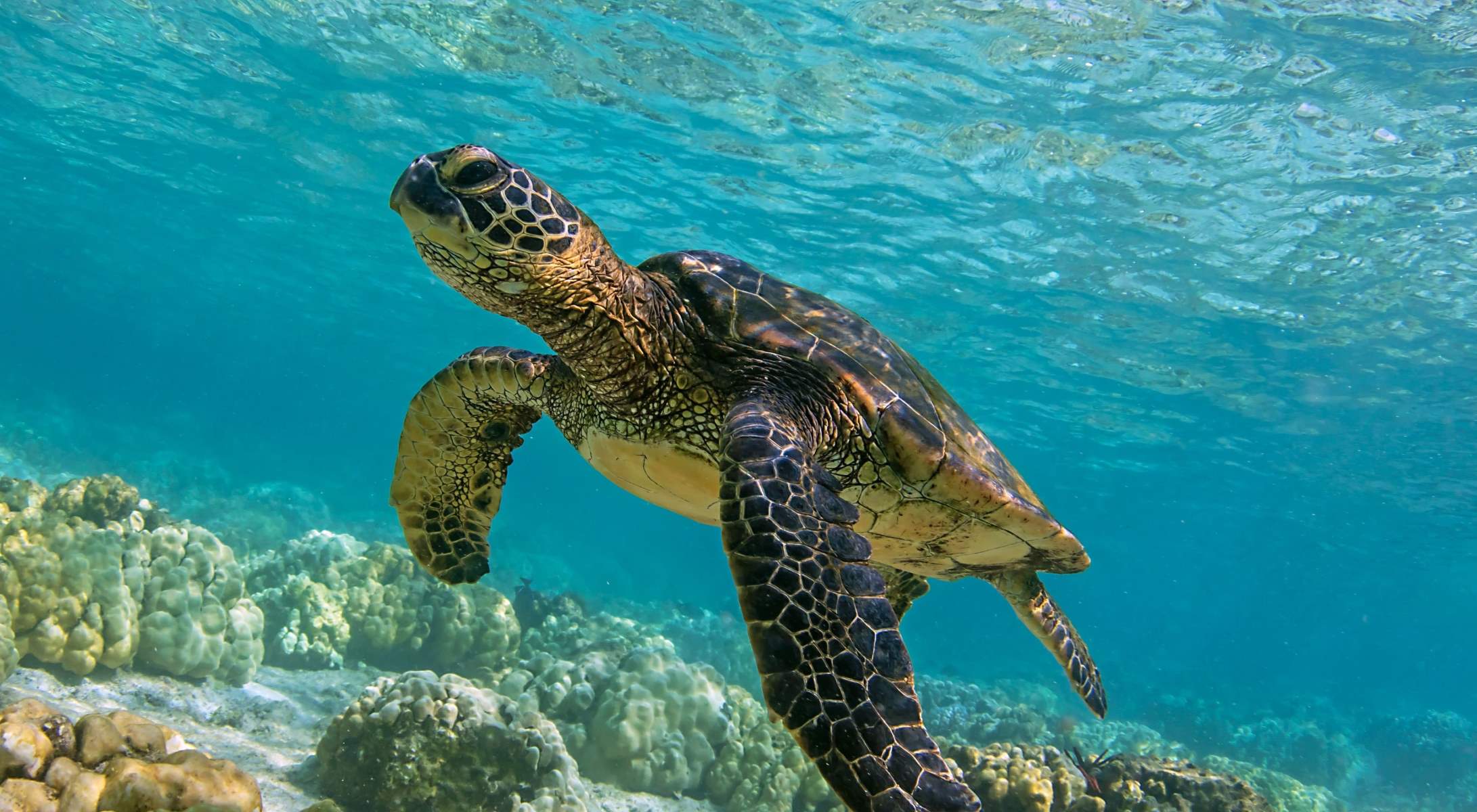
Ever wondered about the majestic creatures that glide through our oceans with grace? Green sea turtles are more than just oceanic travelers; they're a marvel of the marine world. With a lifespan that can stretch over a century, these ancient mariners have been navigating the vast blue long before humans charted the seas. But what makes them so fascinating? From their unique diet that turns their fat green to their incredible journey from beach to ocean as hatchlings, green sea turtles hold secrets of survival and beauty beneath their shells. Ready to dive into some of the most intriguing facts about these serene sea dwellers? Let's plunge into the world of green sea turtles and uncover what makes them truly remarkable.
Key Takeaways:
- Green sea turtles are unique for their diet shift from carnivorous to herbivorous, their ability to hold their breath for hours, and their impressive migrations of over 1,400 miles.
- Conservation efforts are crucial to protect green sea turtles from threats such as coastal development, pollution, and climate change. Their cultural significance and role in marine ecosystems make them worth preserving.
What Makes Green Sea Turtles Unique?
Green sea turtles, known scientifically as Chelonia mydas, stand out for several reasons. Unlike most sea turtles, their diet shifts from carnivorous during their juvenile years to herbivorous as they mature, primarily feasting on seagrasses and algae. This diet is what gives their cartilage and fat a greenish color, hence their name.
-
Green sea turtles can hold their breath for several hours at a time when resting. This remarkable ability allows them to conserve energy and stay submerged for extended periods.
-
They are one of the largest species of sea turtle, with adults typically weighing around 150 to 400 pounds (68 to 181 kilograms).
-
These turtles have a unique method of propulsion in the water, using their powerful front flippers to glide through the ocean. Their flippers can span up to 5 feet (1.5 meters) in adult individuals.
Green Sea Turtle Habitats and Migration
Green sea turtles have a widespread distribution, found in tropical and subtropical seas around the world. They prefer shallow, coastal areas where seagrass beds are abundant, crucial for their herbivorous diet.
-
They are known for their long migrations between feeding sites and nesting beaches. Some turtles travel over 1,400 miles (2,253 kilometers) to reach their preferred nesting site.
-
Nesting sites are typically located on sandy beaches, where female turtles lay their eggs. A single female can lay between 100 to 200 eggs per nest and may nest multiple times during a nesting season.
Threats to Green Sea Turtles
Despite their beauty and ecological importance, green sea turtles face several threats. Human activities, such as coastal development, pollution, and fishing, pose significant risks to their populations.
-
Green sea turtles are considered endangered due to these threats. Conservation efforts are crucial to their survival, including protecting nesting sites and reducing bycatch in fishing gear.
-
Climate change also impacts these turtles, as rising temperatures can skew the sex ratio of hatchlings. Warmer sands tend to produce more female turtles, which could affect future breeding populations.
Conservation Efforts for Green Sea Turtles
Efforts to protect green sea turtles have been implemented globally, involving both legal protection and grassroots conservation initiatives.
-
Many countries have laws that protect green sea turtles, including prohibitions on hunting, egg collection, and habitat destruction.
-
Conservation groups work to monitor nesting sites, rehabilitate injured turtles, and raise public awareness about the threats they face.
-
Satellite tracking technology is increasingly used to study their migration patterns and better understand their behavior, aiding in the development of more effective conservation strategies.
Fascinating Facts About Green Sea Turtle Behavior
Green sea turtles exhibit some fascinating behaviors that have intrigued scientists and nature lovers alike.
-
They are known to return to the exact beach where they were born to lay their eggs, a phenomenon known as natal homing.
-
During nesting, female turtles enter a trance-like state while laying their eggs, which helps them focus on the task at hand and ignore potential threats.
-
Green sea turtles communicate through a variety of sounds, especially during mating and nesting periods. These sounds include clicks, clucks, and grunts.
-
Juvenile green sea turtles are often found in floating seaweed mats, where they find shelter and food. This behavior helps them avoid predators in their vulnerable early stages of life.
-
Interestingly, green sea turtles can sleep underwater, tucking themselves in coral reefs or resting on the ocean floor to avoid predators while they rest.
The Role of Green Sea Turtles in Ecosystems
Green sea turtles play a vital role in marine ecosystems, particularly in maintaining healthy seagrass beds.
-
By feeding on seagrass, they help keep these habitats in good condition, which benefits numerous other marine species.
-
Seagrass beds are important carbon sinks, meaning they help mitigate climate change by absorbing carbon dioxide from the atmosphere.
-
The presence of green sea turtles in an area is often an indicator of a healthy marine ecosystem, as they require clean, productive environments to thrive.
Green Sea Turtle Lifespan and Reproduction
Understanding the lifecycle of green sea turtles provides insight into their survival challenges and the importance of conservation efforts.
-
Green sea turtles have a long lifespan, with some individuals living up to 80 years or more. However, reaching maturity can take 20 to 50 years.
-
The sex of green sea turtle hatchlings is determined by the temperature of the sand where the eggs are incubated. Cooler sands produce more males, while warmer sands produce more females.
-
Hatchlings face numerous predators, including birds, crabs, and fish, as they make their perilous journey from nest to sea. Only a small percentage survive to adulthood.
-
Adult green sea turtles have few natural predators, with large sharks being one of the exceptions. Human activities remain their biggest threat.
The Cultural Significance of Green Sea Turtles
Green sea turtles hold cultural significance for many coastal and island communities around the world.
-
In some cultures, green sea turtles are revered as symbols of navigation and endurance, reflecting their long migrations and ability to navigate vast oceans.
-
Traditional stories and myths often feature turtles as wise creatures that bring important messages or offer guidance.
-
Today, green sea turtles are popular in ecotourism, attracting visitors who wish to observe these majestic animals in their natural habitat. This interest has spurred efforts to protect them and their environments.
-
Conservation education programs that focus on green sea turtles have been effective in engaging communities in protecting these animals and their habitats.
-
Artistic representations of green sea turtles, from paintings to sculptures, celebrate their beauty and highlight the need for their conservation.
-
Finally, green sea turtles contribute to the biodiversity of marine ecosystems, underscoring the interconnectedness of life in our oceans and the importance of preserving these critical habitats for future generations.
A Glimpse Into the Green Sea Turtle's World
Well, we've journeyed through the fascinating world of green sea turtles, uncovering some truly amazing facts. From their incredible navigation skills to their unique diet that turns their fat green, these creatures never cease to amaze. They play a crucial role in marine ecosystems, helping maintain the health of seagrass beds and coral reefs. Despite facing threats from habitat loss, climate change, and poaching, efforts are underway worldwide to protect these magnificent animals. By understanding and appreciating the value of green sea turtles, we can all contribute to their conservation. Let's keep our oceans healthy for generations of green sea turtles to come. After all, a world teeming with such extraordinary creatures is definitely a richer place.
Frequently Asked Questions
Was this page helpful?
Our commitment to delivering trustworthy and engaging content is at the heart of what we do. Each fact on our site is contributed by real users like you, bringing a wealth of diverse insights and information. To ensure the highest standards of accuracy and reliability, our dedicated editors meticulously review each submission. This process guarantees that the facts we share are not only fascinating but also credible. Trust in our commitment to quality and authenticity as you explore and learn with us.


